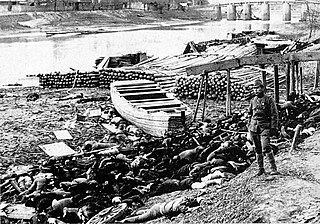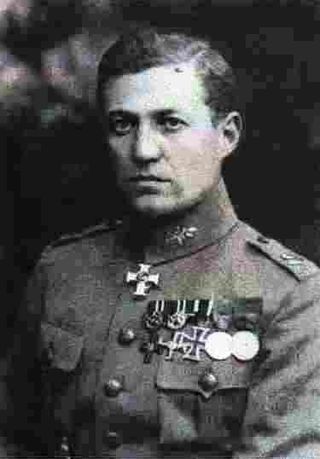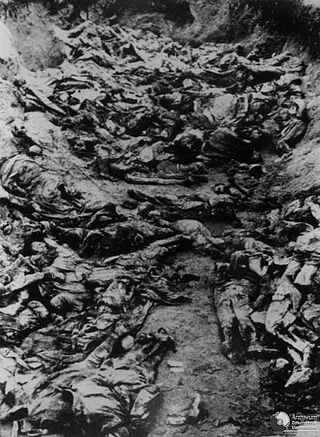
The Waffen-SS was the combat branch of the Nazi Party's paramilitary Schutzstaffel (SS) organisation. Its formations included men from Nazi Germany, along with volunteers and conscripts from both German-occupied Europe and unoccupied lands. It was disbanded in May 1945.

1997 (MCMXCVII) was a common year starting on Wednesday of the Gregorian calendar, the 1997th year of the Common Era (CE) and Anno Domini (AD) designations, the 997th year of the 2nd millennium, the 97th year of the 20th century, and the 8th year of the 1990s decade.

The Nanjing Massacre or the Rape of Nanjing was the mass murder of Chinese civilians in Nanjing, the capital of the Republic of China, immediately after the Battle of Nanking and the retreat of the National Revolutionary Army in the Second Sino-Japanese War, by the Imperial Japanese Army. Beginning on December 13, 1937, the massacre lasted six weeks. The perpetrators also committed other war crimes such as mass rape, looting, torture, and arson. The massacre is considered to be one of the worst wartime atrocities.
The Račak massacre or Račak operation was the massacre of 45 Kosovo Albanians that took place in the village of Račak in central Kosovo in January 1999. The massacre was perpetrated by Serbian security forces in response to Albanian separatist activity in the region. The Serbian government refused to let a war crimes prosecutor visit the site, and maintained that the casualties were all members of the rebel Kosovo Liberation Army (KLA) killed in combat with state security forces.

Martin Eugen Ekström was a Swedish military adventurer who became the leader of the National Socialist Bloc, an umbrella organization for various fascist and National Socialist groups. Ekström was born in By, Avesta Municipality. During the Finnish Civil War, he led the Vasa Regiment which was responsible for the Viipuri massacre. Lieutenant colonel Ekström led the 3rd Battlegroup of the Swedish Volunteer Corps in the Finnish Winter War. He died in Helsinki, aged 67.

The governments of the German Empire and Nazi Germany ordered, organized, and condoned a substantial number of war crimes, first in the Herero and Namaqua genocide and then in the First and Second World Wars. The most notable of these is the Holocaust, in which millions of European Jewish, Polish, and Romani people were systematically abused, deported, and murdered. Millions of civilians and prisoners of war also died as a result of German abuses, mistreatment, and deliberate starvation policies in those two conflicts. Much of the evidence was deliberately destroyed by the perpetrators, such as in Sonderaktion 1005, in an attempt to conceal their crimes.

The Katyn massacre was a series of mass executions of nearly 22,000 Polish military officers and intelligentsia prisoners of war carried out by the Soviet Union, specifically the NKVD in April and May 1940. Though the killings also occurred in the Kalinin and Kharkiv prisons and elsewhere, the massacre is named after the Katyn forest, where some of the mass graves were first discovered by German Nazi forces.

The Jokela school shooting also known as the Jokela High School massacre occurred on 7 November 2007, at Jokela High School in the town of Jokela, Tuusula, Finland. The gunman, 18-year-old Pekka-Eric Auvinen, entered the school that morning armed with a semi-automatic pistol. He killed eight people and wounded one person in the toe before shooting himself in the head; twelve others were also injured by flying glass or by spraining their ankle(s) in the subsequent chaos that ensued. Auvinen died later that evening in a Helsinki hospital.

The Vinnytsia massacre was the mass execution of between 9,000 and 11,000 people in the Ukrainian town of Vinnytsia by the Soviet secret police NKVD during the Great Purge in 1937–1938, which Nazi Germany discovered during its occupation of Ukraine in 1943. The investigation of the site first conducted by the international Katyn Commission coincided with the discovery of a similar mass murder site of Polish prisoners of war in Katyn. Among the 679 dead identified by the Germans in 1943, there were also a certain number of Russians and 28 Poles. Nazi propaganda invoked mention of the massacre to illustrate communist terror by the Soviet Union.
The following outline is provided as an overview of and topical guide to World War II:
"1913 Massacre" is a topical ballad written by American folk singer Woody Guthrie, and recorded and released in 1945 for Moses Asch's Folkways label. The song originally appeared on Struggle, an album of labor songs. It was re-released in 1998 on Hard Travelin', The Asch Recordings, Vol.3 and other albums. The song is about the death of striking copper miners and their families in Calumet, Michigan, on Christmas Eve, 1913, in what is commonly known as the Italian Hall disaster.

Harald Öhquist was a Finnish Jäger and Lieutenant General during World War II.

A massacre is an event of killing people who are not engaged in hostilities or are defenseless. It is generally used to describe a targeted killing of civilians en masse by an armed group or person.

The Camp Speicher massacre was an act of terrorism perpetrated by ISIS on 12 June 2014, against unarmed (Shia) Iraqi cadets near Tikrit Air Academy. As a result of ISIS seizing key provinces in northern Iraq in a large-scale offensive, and the Iraqi army suffering a major collapse, a number of unarmed and ununiformed Iraqi cadets vacated Camp Speicher. A large number of them were subsequently captured by ISIS and summarily executed. In total, between 1,095 and 1,700 cadets were killed. At the time of the massacre, there were between 5,000 and 10,000 unarmed cadets in the vicinity of Camp Speicher, and ISIS militants selected the Shia Muslims for execution. As of 2024, it remains the deadliest act of terrorism in Iraq and the second-deadliest act of terrorism in the world, surpassed only by the September 11 attacks, which were carried out by al-Qaeda against the United States in 2001.
The following lists events that happened during 1944 in the Union of Soviet Socialist Republics.










